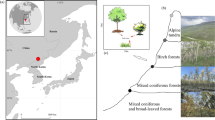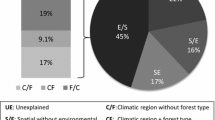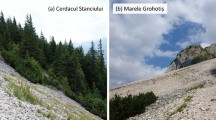Abstract
Many aboveground animals and plant communities have been studied along elevational gradients whereas studies on soil animals are scarce. Here, we studied oribatid mite community distribution along an elevational gradient from 600 to 2200 m in forest ecosystems of the Western Lesser Caucasus Mountains in Georgia. Overall, 86 oribatid mite species were found at the study sites. Oribatid mite densities were generally low (~9800 ind./m2), and 74 % of all species reproduced sexually indicating that resource conditions at the study sites are generally poor. Oribatids mainly comprised Brachypylina (76 %), Mixonomata (13 %), Desmonomata (6 %) and Enarthronota (5 %). Oribatid mite community structure changed along the elevational gradient and the changes correlated with temperature, pH, litter thickness and density of the herb layer. The dominance of sexually reproducing taxa and low overall abundance indicate that the studied elevational gradient is characterized by poor resource conditions for soil microarthropods. Oribatid mite species richness and density declined with elevation suggesting that decreasing temperature in concert with resource limitation is a main driver of oribatid mite communities whereas stochastic factors (such as mid-domain effects) are of minor importance.



Similar content being viewed by others
References
Adams J (2009) Species richness: patterns in the diversity of life. Springer, Chichester
Andrew NR, Rodgerson L, Dunlop M (2003) Variation in invertebrate–bryophyte community structure at different spatial scales along altitudinal gradients. J Biogeogr 30:731–746
Arabuli T, Murvanidze M, Kvavadze E (2004) Distribution of oribatid mites (Acari, Oribatida) by phytocenosis (Tsiv-Gombori Range, East Georgia). Proc Inst Zool 22:80–88
Cianciolo JM, Norton RA (2006) The ecological distribution of reproductive mode in oribatid mites, as related to biological complexity. Exp Appl Acarol 40:1–25
Coleman D, Crossley J, Hendrix P (2004) Fundamentals of soil ecology, 2nd edn. Academic Press, San-Diego
Colwell RK (2008) RangeModel: tools for exploring and assessing geometric constraints on species richness (the mid-domain effect) along transects. Ecography 31:4–7
Colwell RK, Hurtt GC (1994) Nonbiological gradients in species richness and a spurious Rapoport effect. Am Nat 144:570–595
Currie D, Kerr J (2008) Tests of the mid-domain hypothesis: a review of the evidence. Ecol Monogr 78:3–18
Davudova EZ (2013) Pancirnie kleshchi (Acariformes, Oribatida) irganaiskoi kotlovini vnutrennego gornogo Dagestana (fauna, ecologia, zoogeographia). Dissertation, Daghestan State University
Dolukhanov A (2010) Forest vegetation of Georgia. Universal, Tbilisi
Domes K, Scheu S, Maraun M (2007) Resources and sex: soil recolonization by sexual and parthenogenetic oribatid mites. Pedobiologia 51:1–11
Domes-Wehner K (2009) Parthenogenesis and sexuality in oribatid mites: Phylogeny, mitochondrial genome structure and resource dependence. Dissertation, Technischen Universität Darmstadt
Fischer BM, Schatz H (2013) Biodiversity of oribatid mites (Acari: Oribatida) along an altitudinal gradient in the Central Alps. Zootaxa 3626:429–454
Fischer B, Schatz H, Maraun M (2010) Community structure, trophic position and reproductive mode of soil and bark-living oribatid mites in an alpine grassland ecosystem. Exp Appl Acarol 52:221–237
Fischer A, Blaschke M, Bässler C (2011) Altitudinal gradients in biodiversity research: the state of the art and future perspectives under climate change aspects. For Ecol Landsc Nat Conserv Res 11:35–47
Fischer BM, Meyer E, Maraun M (2014) Positive correlation of trophic level and proportion of sexual taxa of oribatid mites (Acari: Oribatida) in alpine soil systems. Exp Appl Acarol 63:465–479
Gaston KJ (2000) Global patterns in biodiversity. Nature 405:220–227
Gerritsen J (1980) Sex and parthenogenesis in sparse populations. Am Nat 115:718–742
Ghilarov MS, Krivolutsky DA (1975) Identification key of soil dwelling mites. Sarcoptiformes, Nauka
Ghobad-Nejhad M, Hallenberg N (2012) The Caucasian corticioid fungi: level of endemism, similarity, and possible contribution to European fungal diversity. Fungal Divers 52:35–48
Glesener R, Tilman D (1978) Sexuality and the components of environmental uncertainty: clues from geographic parthenogenesis in terrestrial animals. Am Nat 112:659–673
Guo Q, Kelt DA, Sun Z et al (2013) Global variation in elevational diversity patterns. Sci Rep 3:3007
Hasegawa M, Ito MT, Kitayama K (2006) Community structure of oribatid mites in relation to elevation and geology on the slope of Mount Kinabalu, Sabah, Malaysia. Eur J Soil Biol 42:S191–S196
Hijmans RJ, Cameron SE, Parra JL et al (2005) Very high resolution interpolated climate surfaces for global land areas. Int J Climatol 25:1965–1978
Illig J, Schatz H (2008) Decomposition and colonization by micro-arthropods of two litter types in a tropical montane rain forest in southern Ecuador. J Trop Ecol 24:157–167
Illig J, Norton RA, Scheu S, Maraun M (2010) Density and community structure of soil- and bark-dwelling microarthropods along an altitudinal gradient in a tropical montane rainforest. Exp Appl Acarol 52:49–62
Jing S, Solhøy T, Huifu W et al (2005) Differences in soil arthropod communities along a high altitude gradient at Shergyla Mountain, Tibet, China. Arctic Antarct Alp Res 37:261–266
Jongman R, Ter Braak C, Van Tongeren O (1995) Data analysis in community and landscape ecology. Cambridge University Press, Cambridge
Kearney M (2005) Hybridization, glaciation and geographical parthenogenesis. Trends Ecol Evol 20:495–502
Kessler M, Kluge J, Hemp A, Ohlemüller R (2011) A global comparative analysis of elevational species richness patterns of ferns. Glob Ecol Biogeogr 20:868–880
Körner C (2000) Why are there global gradients in species richness? Mountains might hold the answer. Trends Ecol Evol 19:513–514
Lamoncha K, Crossley DC Jr (1998) Oribatid mite diversity along an elevation gradient in a southeastern Appalachian forest. Pedobiologia 42:43–55
Leuschner C, Moser G, Bertsch C (2007) Large altitudinal increase in tree root/shoot ratio in tropical mountain forests of Ecuador. Basic Appl Ecol 8:219–230
Lomolino M (2001) Elevation gradients of species-density: historical and prospective views. Glob Ecol Biogeogr 10:3–13
Lomolino M, Riddle B, Brown J (2006) Biogeography. Sinauer Associates, Sunderland
Maraun M, Scheu S (2000) The structure of oribatid mite communities (Acari, Oribatida): patterns, mechanisms and implications for future research. Ecography 23:374–382
Maraun M, Salamon J, Schneider K et al (2003) Oribatid mite and collembolan diversity, density and community structure in a moder beech forest (Fagus sylvatica): effects of mechanical perturbations. Soil Biol Biochem 35:1387–1394
Maraun M, Illig J, Sandman D et al (2008) Soil Fauna. In: Beck E, Benedix J, Kottke I et al (eds) Gradients in a tropical mountain ecosystem of Ecuador. Springer, Berlin, pp 181–193
Maraun M, Erdmann G, Schulz G et al (2009) Multiple convergent evolution of arboreal life in oribatid mites indicates the primacy of ecology. Proc Biol Sci 276:3219–3227
Maraun M, Norton RA, Ehnes RB et al (2012) Positive correlation between density and parthenogenetic reproduction in oribatid mites (Acari) supports the structured resource theory of sexual reproduction. Evol Ecol Res 14:311–323
Maraun M, Fronczek S, Marian F et al (2013) More sex at higher altitudes: changes in the frequency of parthenogenesis in oribatid mites in tropical montane rain forests. Pedobiologia 56:185–190
Mittermeier RAA, Gil PR, Hoffman M et al (2004) Hotspots Revisited: Earth’s biologically richest and most endangered ecoregions. CEMEX/Agrupacion Sierra Madre, Sierra Madre
Mori A, Shiono T, Koide D (2013) Community assembly processes shape an altitudinal gradient of forest biodiversity. Glob Ecol Biogeogr 22:878–888
Mumladze L, Murvanidze M, Behan-Pelletier V (2013) Compositional patterns in Holarctic peat bog inhabiting oribatid mite (Acari: Oribatida) communities. Pedobiologia 56:41–48
Murvanidze M, Kvavadze E (2009) Oribatid mites, the main decomposers of bogs of Colchic Lowland (Caucasus, Georgia). In: Sabelis M, Bruin J (ed) Proceeding of the XII congress of acarology, pp 175–178
Murvanidze M, Kvavadze E, Jgenti L (2004) Oribatid mites (Acari, Oribatei) of Ajara (Caucasus, Georgia) and their vertical-zonal distribution. Proc Inst Zool Tbilisi 22:89–102
Murvanidze M, Kvavadze E, Mmumladze L, Arabuli T (2011) Landscape distribution of oribatid mites (Acari, Oribatida) in Kolkheti National Park (Georgia, Caucasus). Zoosymposia 6:202–214
Nakhutsrishvili G (2013) The Vegetation of Georgia (South Caucasus), 2nd edn. Springer, Berlin
Neidze V (2003) Sakartvelos sotsialur-ekonomikuri geografia (Social-economic geography of Georgia). Metsniereba, Tbilisi
Norton RA, Kethley JB, Johnston DE, O’Connor BM (1993) Phylogenetic perspectives on genetic systems and reproductive modes of mites. In: Wrensch DL, Ebbert MA (eds) Evolution and diversity of sex ratio in insects and mites. Chapman & Hall, New York, pp 8–99
Olson DM (1994) The distribution of leaf litter invertebrates along a Neotropical altitudinal gradient. J Trop Ecol 10:129–150
Pokryszko BM, Cameron RAD, Mumladze L, Tarkhnishvili D (2011) Forest snail faunas from Georgian Transcaucasia : patterns of diversity in a Pleistocene refugium. Biol J Linn Soc 102:239–250
Rahbek C (1995) The elevational gradient of species richness: a uniform pattern? Ecography 18:200–205
Rahbek C (2005) The role of spatial scale and the perception of large-scale species-richness patterns. Ecol Lett 8:224–239
Rohde K (1992) Latitudinal gradients in species diversity: the search for the primary cause. Oikos 65:514–527
Romdal TS, Grytnes J (2007) An indirect area effect on elevational species richness patterns. Ecography 30:440–448
Schatz H (1978) Oribatiden-Gemeinschaften (Acari: Oribatei) oberhalb der Waldgrenze im Raum Obergurgl (Tirol, Österreich). Berichte des naturwissenschaftlich-medizinischen Vereins Innsbruck, 65:55–72
Scheu S, Drossel B (2007) Sexual reproduction prevails in a world of structured resources in short supply. Proc Biol Sci 274:1225–1231
Schneider K, Renker C, Scheu S, Maraun M (2004a) Feeding biology of oribatid mites: a minireview. Phytophaga 16:247–256
Schneider K, Migge S, Norton RA, Scheu S, Langel R, Reineking A, Maraun M (2004b) Trophic niche differentiation in soil microarthropods (Oribatida, Acari): evidence from stable isotope ratios (15N/14N). Soil Biol Biochem 36:1769–1774
Shatilova I, Mchedlishvili N, Rukhadze L, Kvavadze E (2011) The history of the flora and vegetation of Georgia (South Caucasus). Georgian National Museum, Tbilisi
Shtanchaeva UY (2003) Structure of soil-dwelling microarthropod communities (Collembola, Oribatida) in Mountainous Daghestan. Russ J Zool 82:665–671
Song Y, Scheu S, Drossel B (2011) Geographic parthenogenesis in a consumer-resource model for sexual reproduction. J Theor Biol 273:55–62
Song Y, Scheu S, Drossel B (2012) The ecological advantage of sexual reproduction in multicellular long-lived organisms. J Evol Biol 25:556–565
Tarba ZM (1993) Population structure of the oribatid mites in the vertical landscape zones of Abkhazia. Russ J Zool 72:22–27
Ter Braak C, Smilauer P (2002) CANOCO reference manual and CanoDraw for Windows user’s guide: software for canonical community ordination (version 4.5). Microcomputer Power Ithaca, New York
Wehner K, Scheu S, Maraun M (2014) Resource availability as arriving a actor of the reproductive mode in soil microarthropods (Acari, Oribatida). PLoS One 9(8):e104243
Weigmann G (2006) Hornmilben (Oribatida). Die Tierwelt Deutschlands. 6 Teil. Goecke and Evers, Keltern
Willig MR, Kaufman DM, Stevens RD (2003) Latitudinal gradients of biodiversity: pattern, process, scale, and synthesis. Annu Rev Ecol Evol Syst 34:273–309
Zaitsev AS, Straalen NM, Berg MP (2013) Landscape geological age explains large scale spatial trends in oribatid mite diversity. Landsc Ecol 28:285–296
Zapata FA, Gaston KJ, Chown SL (2003) Mid-domain models of species richness gradients: assumptions, methods and evidence. J Anim Ecol 72:677–690
Acknowledgments
The field work of L. Mumladze was supported by the DAAD (Deutscher Akademischer Austausch Dienst) foundation. We would like to thank Zezva Asanidze for helping in the field work and Mary Shalamberidze for measuring of soil pH (students of Ilia State University). We thank Prof. Stefan Scheu and reviewers for useful comments and suggestions on the manuscript.
Author information
Authors and Affiliations
Corresponding author
Electronic supplementary material
Below is the link to the electronic supplementary material.
Rights and permissions
About this article
Cite this article
Mumladze, L., Murvanidze, M., Maraun, M. et al. Oribatid mite communities along an elevational gradient in Sairme gorge (Caucasus). Exp Appl Acarol 66, 41–51 (2015). https://doi.org/10.1007/s10493-015-9893-4
Received:
Accepted:
Published:
Issue Date:
DOI: https://doi.org/10.1007/s10493-015-9893-4




